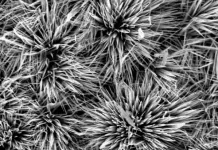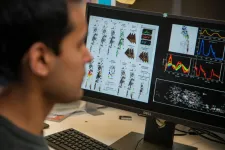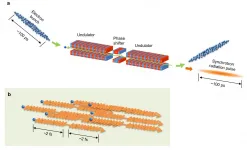(Press-News.org) COLUMBUS, Ohio - Electricity may slow - and in some cases, stop - the speed at which breast cancer cells spread through the body, a new study indicates.
The research also found that electromagnetic fields might hinder the amount of breast cancer cells that spread. The findings, published recently in the journal Bioelectricity, suggest that electromagnetic fields might be a useful tool in fighting cancers that are highly metastatic, which means they are likely to spread to other parts of the body, the authors said.
"We think we can hinder metastasis by applying these fields, but we also think it may be possible to even destroy tumors using this approach," said Vish Subramaniam, senior author of the paper and former professor of mechanical and aerospace engineering at The Ohio State University. Subramaniam retired from Ohio State in December.
"That is unclear at this stage, but we are working on understanding that - how big should the electromagnetic field be, how close should it be to the tumor? Those are the next questions we hope to answer."
The study is among the first to show that electromagnetic fields could slow or stop certain processes of a cancer cell's metabolism, impairing its ability to spread. The electromagnetic fields did not have a similar effect on normal breast cells.
Travis Jones, lead author of the paper and a researcher at Ohio State, compared the effects to what might happen if something interfered with a group running together down a path.
The effect, Subramaniam said, is that some of the cancer cells slow down when confronted with electromagnetic fields.
"It makes some of them stop for a little while before they start to move, slowly, again," he said. "As a group, they appear to have split up. So how quickly the whole group is moving and for how long they are moving becomes affected."
The electromagnetic fields are applied to cancerous cells without touching them, said Jonathan Song, co-author of the paper, associate professor of mechanical and aerospace engineering at Ohio State and co-director of Ohio State's Center for Cancer Engineering.
Song compared the cancer cells with cars. Each cell's metabolism acts as fuel to move the cells around the body, similar to the way gasoline moves vehicles.
"Take away the fuel, and the car cannot move anymore," Song said.
The work was performed on isolated human breast cancer cells in a lab and has not been tested clinically.
The electromagnetic fields appear to work to slow cancer cells' metabolism selectively by changing the electrical fields inside an individual cell. Accessing the internal workings of the cell, without having to actually touch the cell via surgery or another more invasive procedure, is new to the study of how cancer metastasizes, Subramaniam said.
"Now that we know this, we can start to answer other questions, too," Subramaniam said. "How do we affect the metabolism to the point that we not only make it not move but we choke it, we completely starve it. Or can we slow it down to the point where it will always remain weak?"
INFORMATION:
This research is an extension of two previous pioneering studies, published in 2015 and 2019, that showed electromagnetic fields could hinder breast cancer metastasis. (Read an Ohio State News story about the 2019 study here.)
Other Ohio State researchers who authored this study include Kirti Kaul, Ayush Garg and Ramesh Ganju.
CONTACTS: Vish Subramaniam, Subramaniam.1@osu.edu
Jonathan Song, song.1069@osu.edu
Written by Laura Arenschield, arenschield.2@osu.edu
PHILADELPHIA (March 17, 2021) - Stroke remains a leading cause of death worldwide and one of the most common reasons for disability. While a wide variety of factors influence stroke outcomes, data show that avoiding readmissions and long lengths of stay among ischemic stroke patients has benefits for patients and health care systems alike. Although reduced readmission rates among various medical patients have been associated with better nurse work environments, it is unknown how the work environment might influence readmissions and length of stay for ischemic stroke patients.
In a new study from the University of Pennsylvania School of Nursing's (Penn Nursing) Center for Health Outcomes ...
The NASA-funded Seismometer to Investigate Ice and Ocean Structure (SIIOS) performed well in seismic experiments conducted in snowy summer Greenland, according to a new study by the SIIOS team led by the University of Arizona published this week in Seismological Research Letters.
SIIOS could be a part of proposed NASA spacecraft missions to the surface of Europa or Enceladus. These moons of Jupiter and Saturn are encrusted by an icy shell over subsurface liquid oceans, and seismic data could be used to better define the thickness and depth of these layers. Other seismic points of interest on these worlds could include ice volcanoes, drainage events below the ice shell and possibly even ...
East Hanover, NJ. March 17, 2021. Kessler Foundation researchers have identified several practical and technical barriers to the widespread use of surface electromyography (sEMG) in clinical neurorehabilitation. Based on their holistic analysis of these factors, the researchers suggest a collaborative, interdisciplinary, and unified approach to enable rehabilitation professionals to routinely use sEMG. The article, "Use of Surface EMG in Clinical Rehabilitation of Individuals With SCI: Barriers and Future Considerations" (doi: 10.3389/fneur.2020.578559), was published December 18, 2020, in Frontiers in Neurology. It is available open access at https://www.ncbi.nlm.nih.gov/pmc/articles/PMC7780850/
The authors are Rakesh ...
Autoimmune diseases are typically caused when the immune system, whose purpose is to deal with foreign threats to the body, incorrectly recognizes the body's own proteins and cells as threats and activates immune cells to attack them. In the case of rheumatoid arthritis, a well-known autoimmune disease, immune cells erroneously attack the body's own joint components and proteins, causing painful inflammation and even the destruction of bone! Scientists from Japan have now taken a massive step toward understanding and, potentially, treating rheumatoid arthritis better, with their discovery in a brand-new study. Read on to understand how!
The development of autoimmune diseases is an incredibly complex process, involving several key players ...
A sustainable, powerful micro-supercapacitor may be on the horizon, thanks to an international collaboration of researchers from Penn State and the University of Electronic Science and Technology of China. Until now, the high-capacity, fast-charging energy storage devices have been limited by the composition of their electrodes -- the connections responsible for managing the flow of electrons during charging and dispensing energy. Now, researchers have developed a better material to improve connectivity while maintaining recyclability and low cost.
They published their results on Feb. 8 in the Journal of Materials Chemistry A.
"The supercapacitor is a very powerful, energy-dense device with a fast-charging rate, in contrast to the typical battery ...
An international collaboration between Great Ormond Street Hospital, the UCL GOS Institute for Child Health and Harvard Medical School has shown that the beneficial effects of gene therapy can be seen decades after the transplanted blood stem cells has been cleared by the body.
The research team monitored five patients who were successfully cured of SCID-X1 using gene therapy at GOSH. For 3-18 years patients' blood was regularly analysed to detect which cell types and biomarker chemicals were present in their blood. The results showed that even though the stem cells transplanted as part of gene therapy had been cleared by the patients, the all-important corrected immune cells, called T-cells, were still forming.
Gene therapy works by first removing ...
In researching the causes and potential treatments for degenerative conditions such as Alzheimer's or Parkinson's disease, neuroscientists frequently struggle to accurately identify cells needed to understand brain activity that gives rise to behavior changes such as declining memory or impaired balance and tremors.
A multidisciplinary team of Georgia Institute of Technology neuroscience researchers, borrowing from existing tools such as graphical models, have uncovered a better way to identify cells and understand the mechanisms of the diseases, potentially leading to better understanding, diagnosis, and treatment.
Their research findings were reported Feb. 24 in the journal eLife. The research was supported by the National Institutes of ...
Hydrogen is a pollution-free energy source when it's extracted from water using sunlight instead of fossil fuels. But current strategies for "splitting" or breaking apart water molecules with catalysts and light require the introduction of chemical additives to expedite the process. Now, researchers reporting in ACS ES&T Engineering have developed a catalyst that destroys medications and other compounds already present in wastewater to generate hydrogen fuel, getting rid of a contaminant while producing something useful.
Harnessing the sun's energy to split water to make hydrogen fuel is a promising renewable resource, but it is a slow process even when catalysts are used to speed it along. In some cases, alcohols or sugars are added to boost the rate of hydrogen production, ...
NEW YORK (March 17, 2021) -- High speed air dryers not only leave more contamination on poorly washed hands compared to paper towels, but during hand drying, they can also spread germs onto clothing, ultimately transferring more bacteria to other surfaces, according to a study published today in Infection Control & Hospital Epidemiology, the journal of the Society for Healthcare Epidemiology of America.
Past research has shown recommended handwashing practices for healthcare workers are often not followed with average adherence of 40%. To better understand the impact of hand drying in hand hygiene, researchers conducted an experiment to learn the role of different hand drying methods in spreading germs from poorly washed hands beyond the restroom.
For ...
Scientists in Japan have observed, and interfered with, the ultrafast motion of electron movement inside of a Xenon atom using the coherent pairs of short light waves in synchrotron radiation. Xenon, consisting of a nucleus surrounded by five nested shells containing a total of 54 electrons, is used in flash lamps, and it burns bright and fast. The luminescent electrons move there on a time scale of one billionth of a second. The fast electron movement is however six orders of magnitude slower than that the scientists observed. Using the synchrotron facility at Institute for Molecular Science, they tracked the electron movement in relaxation to shed energy by dropping from an outer shell to an inner shell. The process happens at a timescale of femtoseconds, ...




